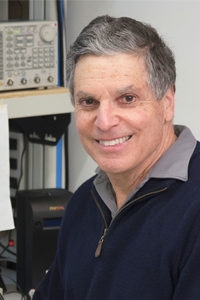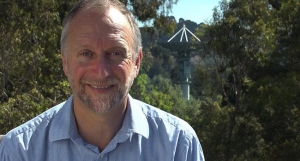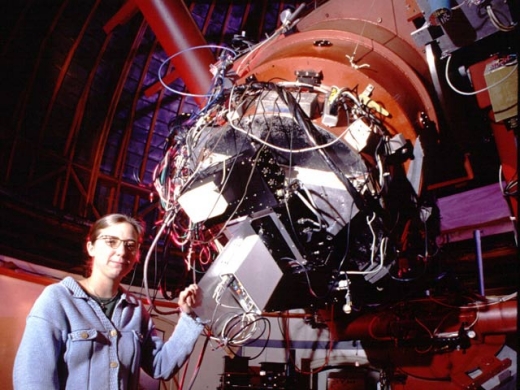Yesterday I made mention of the Schwartz and Townes paper “Interstellar and Interplanetary Communication by Optical Masers,” which ran in Nature in 1961 (Vol. 190, Issue 4772, pp. 205-208). Whereas the famous Cocconi and Morrison paper that kicked off radio SETI quickly spawned an active search in the form of Project Ozma, optical SETI was much slower to develop. The first search I can find is a Russian project called MANIA, in the hands of V. F. Shvartsman and G. M. Beskin, who searched about 100 objects in the early 1970s, finding no significant brightness variations within the parameters of their search.

If you want to track this one down, you’ll need a good academic library, as it appears in the conference proceedings for the Third Decennial US-USSR Conference on SETI, published in 1993. Another Shvartsman investigation under the MANIA rubric occurred in 1978. Optical SETI did not seem to seize the public’s imagination, perhaps partially because of the novelty of communications through the recently discovered laser. We do see several optical SETI studies at UC-Berkeley’s Leuschner Observatory and Kitt Peak from 1979 to 1981, the work of Francisco Valdes and Robert Freitas, though these were searches for Bracewell probes within the Solar System rather than attempts to pick up laser transmissions from other star systems.
Image: Harvard’s Paul Horowitz, a key player in the development of optical SETI. Credit: Harvard University.
This was an era when radio searches for extraterrestrial technology had begun to proliferate, but despite the advocacy of Townes and others (and three conferences Townes helped create), it wasn’t until the 1990s that optical SETI began to come into its own. Charles Townes himself was involved in a search for laser signals from about 300 nearby stars in the ’90s, using the 1.7-meter telescope on Mt. Wilson and reported on at the 1993 conference. Stuart Kingsley began an optical SETI search using the 25-centimeter telescope at the Columbus Optical SETI Observatory (COSETI) in 1990, while Gregory Beskin searched for optical signals at the Special Astrophysical Observatory run by the Russian Academy of Sciences in the Caucasus in 1995.
Optical SETI’s advantages were beginning to be realized, as Andrew Howard (Caltech) commented in a 2004 paper:
The rapid development of laser technology since that time—a Moore’s law doubling of capability roughly every year—along with the discovery of many microwave lines of astronomical interest, have lessened somewhat the allure of hydrogen-line SETI. Indeed, on Earth the exploitation of photonics has revolutionized communications technology, with high-capacity fibers replacing both the historical copper cables and the long-haul microwave repeater chains. In addition, the elucidation (Cordes & Lazio 1991) of the consequences to SETI of interstellar dispersion (first seen in pulsar observations) has broadened thinking about optimum wavelengths. Even operating under the prevailing criterion of minimum energy per bit transmitted, one is driven upward to millimetric wavelengths.

In the late 90’s, the SETI Institute, as part of a reevaluation of SETI methods, recommended and then co-funded several optical searches including one by Dan Werthimer and colleagues at UC Berkeley and another by a Harvard-Smithsonian team including Paul Horowitz and Andrew Howard. The Harvard-Smithsonian group also worked in conjunction with Princeton University on a detector system similar to the one mounted on Harvard’s 155-centimeter optical telescope. A newer All-Sky Optical SETI (OSETI) telescope, set up at the Oak Ridge Observatory at Harvard and funded by The Planetary Society, dates from 2006.
Image: Dan Werthimer, chief scientist at the Berkeley SETI Research Center. Credit: UC-Berkeley.
At Berkeley, the optical SETI effort is led by Werthimer, who had built the laser detector for the Harvard-Smithsonian team. Optical SETI efforts from Leuschner Observatory and Lick Observatory were underway by 1999. Collaborating with Shelley Wright (UC Santa Cruz), Remington Stone (UC Santa Cruz/Lick Observatory), and Frank Drake (SETI Institute), the Berkeley group has gone on to develop new detector systems to improve sensitivity. As I mentioned yesterday, UC-Berkeley’s Nate Tellis, working with Geoff Marcy, has analyzed Keck archival data for 5,600 stars between 2004 and 2016 in search of optical signals.
Working in the infrared, the Near-Infrared Optical SETI instrument (NIROSETI) is designed to conduct searches at infrared wavelengths. Shelley Wright is the principal investigator for NIROSETI, which is mounted on the Nickel 1-meter telescope at Lick Observatory, seeing first light in March of 2015. The project is designed to search for nanosecond pulses in the near-infrared, with a goal “to search not only for transient phenomena from technological activity, but also from natural objects that might produce very short time scale pulses from transient sources.” The advantage of near-infrared is the decrease in interstellar extinction, the absorption by dust and gas that can sharply impact the strength of a signal.

Image: Shelley Wright, then a student at UC-Santa Cruz, helped build a detector that divides the light beam from a telescope into three parts, rather than just two, and sends it to three photomultiplier tubes. This arrangement greatly reduces the number of false alarms; very rarely will instrumental noise trigger all three detectors at once. The three-tube detector is in the white box attached here to the back of the 1-meter Nickel Telescope at Lick Observatory. Credit: Seth Shostak.
I might also mention METI International’s Optical SETI Observatory at Boquete, Panama. The idea is to put the optical SETI effort in context. With the SETI Institute now raising money for its Laser SETI initiative — all-sky all-the-time — the role of private funding in making optical SETI happen is abundantly clear. And now, of course, we also have Breakthrough Listen, which in addition to listening at radio wavelengths at the Parkes instrument in Australia and the Green Bank radio telescope in West Virginia, is using the Automated Planet Finder at Lick Observatory to search for optical laser transmissions. Funded by the Breakthrough Prize Foundation, the project continues the tradition of private funding from individuals, institutions (the SETI Institute) and organizations like The Planetary Society to get optical SETI done.



All of this is incredibly fascinating. We are at that stage in our technological development as a species where our ability to “look and wonder” is greatly increasing at a rate that is roughly equivalent to Moore’s Law. It’s disappointing that we can’t easily get anywhere yet… but our ability to look and listen is really getting fantastic.
But while were waiting for the technology to get somewhere, we are certainly learning where we would want to go.
Re: nanosecond pulses, doesn’t ISM smear the sharp pulse edges? I mean, even at NIR nanosecond makes a long wave train, but anyways, it should not pass unscathed through plasma. What’s the realistic detection distance?
Each technology cycle brings a new communication method that we then apply in our SETI experiments. Radio beacons to radio pulses, optical beacons and now optical nanopulses.
What happens if it proves possible to use entanglement or something similar to send messages? We cannot eavesdrop on that, so ETI remains hidden from exposure via communications. At some point we will have to focus on very different detection methods, probably originating from the other end – the search for life that extends to looking for artifacts of civilization, rather than assuming technological intelligence. There may be more low tech civs struggling with Malthusian conditions than high tech ones that have successfully managed to stabilize their economies and technologies as we are not.
What a surprise if telescopes eventually show clear indications of civilizations – political boundaries marked by different farming or habitat management, cities, pollution, etc, but no indication of advanced communications or high energy emissions.
If such signs were within a reasonable flight time, we might want to send probes to study them, perhaps even communicate with our AI avatars.
I am concerned that one of the programs that SKA was supposed to conduct, SETI, will be removed in order to save money.
Cutbacks hit SKA radio telescope project:
http://physicsworld.com/cws/article/news/2017/jul/27/cutbacks-hit-radio-telescope-project
http://astrobiology.com/2017/07/the-breakthrough-listen-search-for-intelligent-life-a-wideband-data-recorder-system-for-the-robert-c.html
The Breakthrough Listen Search for Intelligent Life: A Wideband Data Recorder System for the Robert C. Byrd Green Bank Telescope
Press Release – Source: astro-ph.IM
Posted July 26, 2017 11:38 AM
The Breakthrough Listen Initiative is undertaking a comprehensive search for radio and optical signatures from extraterrestrial civilizations.
An integral component of the project is the design and implementation of wide-bandwidth data recorder and signal processing systems. The capabilities of these systems, particularly at radio frequencies, directly determine survey speed; further, given a fixed observing time and spectral coverage, they determine sensitivity as well.
Here, we detail the Breakthrough Listen wide-bandwidth data recording system deployed at the 100-m aperture Robert C. Byrd Green Bank Telescope. The system digitizes up to 6 GHz of bandwidth at 8 bits for both polarizations, storing the resultant 24 GB/s of data to disk. This system is among the highest data rate baseband recording systems in use in radio astronomy. A future system expansion will double recording capacity, to achieve a total Nyquist bandwidth of 12 GHz in two polarizations.
In this paper, we present details of the system architecture, along with salient configuration and disk-write optimizations used to achieve high-throughput data capture on commodity compute servers and consumer-class hard disk drives.
David H.E. MacMahon, Danny C. Price, Matthew Lebofsky, Andrew P. V. Siemion, Steve Croft, David DeBoer, J. Emilio Enriquez, Vishal Gajjar, Gregory Hellbourg, Howard Isaacson, Dan Werthimer, Zuhra Abdurashidova, Marty Bloss, Ramon Creager, John Ford, Ryan S. Lynch, Ronald J. Maddalena, Randy McCullough, Jason Ray, Mark Whitehead, Dave Woody
(Submitted on 19 Jul 2017 (v1), last revised 20 Jul 2017 (this version, v2))
Subjects: Instrumentation and Methods for Astrophysics (astro-ph.IM)
Cite as: arXiv:1707.06024 [astro-ph.IM] (or arXiv:1707.06024v2 [astro-ph.IM] for this version)
Submission history
From: David MacMahon [view email]
[v1] Wed, 19 Jul 2017 11:27:34 GMT (6637kb,D)
[v2] Thu, 20 Jul 2017 09:06:42 GMT (6637kb,D)
https://arxiv.org/abs/1707.06024
Astrobiology
SETI